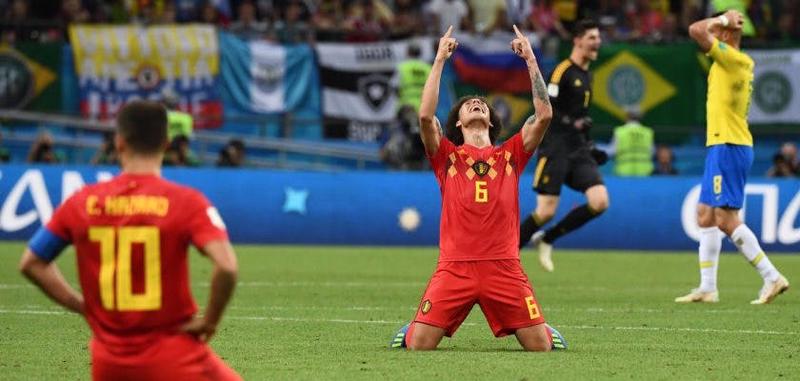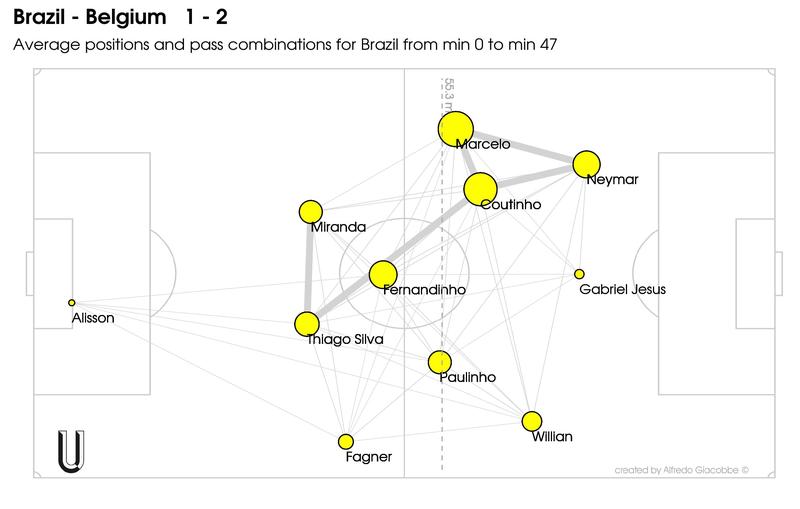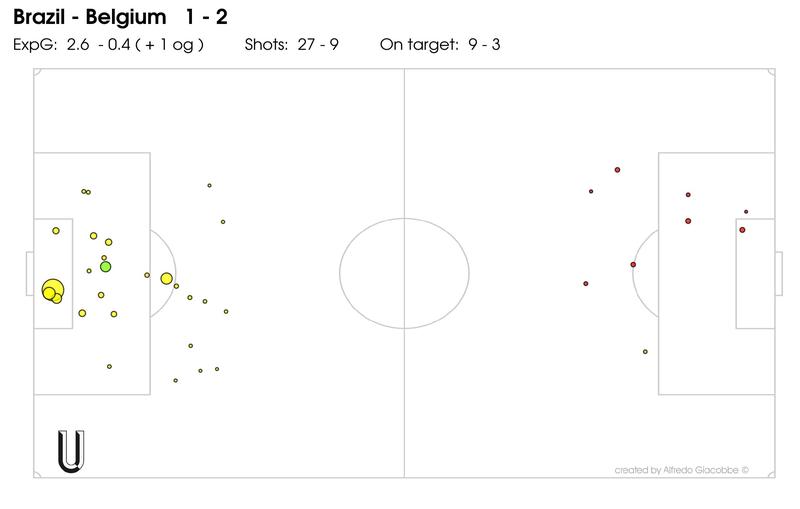Martinez turned the team upside down and managed to contain and beat a brilliant but inaccurate Brazil.

On paper, Belgium's path to the quarterfinals was even better than Brazil's, thanks to 4 consecutive wins and the tournament's best attack record of 12 goals scored. The CT Roberto Martínez, however, had not yet given a balance to the large amount of talent available to him, a theme that emerged clearly during the last of sixteen against Japan, which had exploited the defensive dysfunctionality of Belgium (the distances between defense and midfield, the inferiority on the sides, the instability of transitions) to take advantage of two goals before being comebacked in the last twenty minutes.
The 3-2 on Japan had bequeathed structural limits that Brazil would have no difficulty in punishing and gave further confirmation of the variety of solutions to which Martínez can appeal, which had changed the match by sending into the field Fellaini and Chadli, authors of two of the three goals that marked the comeback on the Japanese. The complexity of the challenge against Brazil, evident not only for the great offensive potential but also for the balance achieved by the Brazilians (a single goal taken at the debut from Switzerland on the development of a corner kick followed by three wins for 2-0), imposed Belgium a much more careful and convincing performance than that against Japan.
Martinez's choices to defend Brazil
It was hard to imagine, however, that Martínez would literally overturn his team. Not only in the choice of the men, with Fellaini and Chadli, promoted on the first team in place of Mertens and Ferreira Carrasco, but also in the system and in the style of play. To limit Brazil's strengths and try to solve the problems shown by Japan, Martínez chose to defend himself with 4-3-3, thus giving up the defense to 5. Even more surprising, however, was the position was taken by some players: at the center of the trident, there was, in fact, De Bruyne, with Lukaku who slipped on the right wing and Hazard who instead remained left.
It is very likely that, in the plan imagined by Martínez, the advancement of De Bruyne and his qualities in pressure sharpened with Guardiola would have had to pollute the first Brazilian construction, also ensuring greater central protection with a player willing to lower and press from behind the ball carrier. Together with Courtois and Fellaini, De Bruyne was the best Belgian for recovered balls: 7.
Lukaku's enlargement, on the other hand, had an offensive meaning: once the ball had been recovered, the Manchester United striker could have run into the spaces left by Marcelo, one of the most vulnerable areas in Brazil. Lukaku and Hazard, lined up on his beloved left side, were the points of reference that should have earned the team meters after recovering the ball. Having a lot of ground to attack in transition (Belgium's ball recoveries stood at a rather low height: 29.5 meters), the resistance to pressure by Hazard and Lukaku, their ability to protect the ball, turn around and burn the grass running was a key part of the strategy devised by Martínez.
The success of the Belgian plan could only go from a great match of the three most advanced players, and none of the three has disappointed expectations. Lukaku constructed the 2-0 goal by protecting the ball and starting again after a corner kick taken by Brazil, De Bruyne converted his team-mate's assist into a goal, while Hazard, even if he didn't create any chance and only shot twice, cleaned up every ball coming out of the defence with exceptional quality, triggering starts or giving the team the chance to go up. The Belgian number 10 didn't miss even one of the 10 dribbling attempts and suffered 7 fouls, more than double than Neymar.
Reconciling the advanced positions of Lukaku, Hazard and De Bruyne, which were decisive for not being crushed by Brazil and ensuring dangerous starts, with the defensive balance offered by the teammates behind him was, however, the real critical point that would have decided the game of Belgium. Accepted the risk of letting the Brazilians advance on the sides, in the spaces behind Lukaku and Hazard, Martínez had prepared different mechanisms depending on the side in which the Brazilian maneuver developed.
Fellaini remained closer to Witsel, granting side receptions to the three Brazilians most involved in the game, Marcelo, Coutinho, and Neymar, to better protect the center and then the possible returns inside the field with the ball at the foot of Coutinho and Neymar. On the left, Chadli started off surprisingly in the role of half-beam and then expanded on the side to help Vertonghen, good at canceling Willian with a careful and punctual marking throughout the first half.
In this way, Martínez has improved both the protection of the central spaces between defense and midfield and the coverage of the width, thanks to the support given by the medians to both the median, Witsel, and the quarterbacks, Meunier on the right and Vertonghen on the left.
The new system designed by Martínez has not only brought benefits to the Belgian game. For example, the setting phase, entrusted to the defenders, Witsel and Fellaini, was not very fluid. Probably Martínez had imagined using the classic 4-sided defensive layout, with the quarterbacks advanced and the midfielders open, to ensure a clean construction in numerical superiority against the first pressure line of Brazil. As the minutes went by, however, Belgium preferred to build with the classic 3-line, with Vertonghen blocked next to the central defenders and Meunier higher, a solution that, however, gave the three Brazilian strikers more precise references to press.
De Bruyne's progress took the Belgian set-up to its limits. Fellaini and Witsel were not very quick in moving the ball and moving the action forward, the latter being particularly exposed to the pressure from behind by Gabriel Jesus. De Bruyne and Hazard very often, during the first part of the challenge, had to lower themselves to facilitate the advancement. In the action that led to the corner kick that unlocked the match, De Bruyne lowered near Vertonghen but was ignored by his team-mate, who chose to pass the ball on the side to Chadli. From that position, however, the midfielder of the City could receive the shore of Lukaku and see the inclusion of Fellaini, served with a nice pass that has put him in a position to shoot from the edge of the area. The deviation of Miranda led to the corner being deflected by Fernandinho into his own goal.
Tite's choices in the second half
Martínez's plan worked especially in the first half, during which Belgium scored two goals and the count of shots remained more or less the same: 10 to 8 in favor of Brazil, but with half of the Brazilians conclusions rejected by the Belgians. In the second half the game changed, thanks to the substitution decided by Tite, who took Willian off and added Firmino. Brazil moved up to 4-4-2, approached Coutinho, Neymar, Firmino and Gabriel Jesus to increase the danger in the last third of the field and began to attack also on the right, an area practically unexplored throughout the first half, with Willian marked well by Vertonghen and Fagner worried about keeping the position.

Asking Miranda and Fagner for more aggressiveness in marking on Lukaku and Hazard, respectively, Tite has also limited the offensive starts in Belgium, a fundamental aspect for not losing the hopes of a resounding comeback. Martínez's team, throughout the second half, only shot once with Hazard and the reduced danger in restarts reflected negatively on the defensive hold. Containing Brazil, permanently in the Belgian half of the field, without interrupting his monologue with the restarts, has become increasingly difficult. Belgium began to lengthen more easily and conceded a goal to Renato Augusto just after a restart stopped by the Brazilians.
Coutinho had time to control the ball and approach the area from the center-left, Fellaini and Witsel waited without putting pressure on him and the number 11 of Brazil was able to raise the ball with great quality on the inclusion of Renato Augusto behind Kompany. The action recalled Paulinho's goal against Serbia, for how it combined Coutinho's sensitivity and vision with the ballless insertions of the midfielders.

For the occasions created, Brazil would not have deserved the defeat. In the second half, they had 17 shots, and they only conceded one chance.
Brazil, however, has been inaccurate in the last few meters, even with its best players. Coutinho was the best of his team, he served the assist for the goal of Renato Augusto, but he made a big mistake for the 2 - 2 with a flat shot "easy" for his qualities; Neymar created much as usual (7 key passes), but was not brilliant in the final runs and was well limited by Meunier in the one on one.
The changes made by Tite have improved Brazil's performance, but in the end, it was Martínez's plan that won the challenge. The former Everton coach has taken risks by changing the setting of the team so far and assigning different positions and tasks to some players. The strategy, designed to hit the weaknesses of Brazil and solve some of the problems that emerged after the first matches, worked especially in the first half, losing effectiveness when the restarts were limited.
Although it has guaranteed greater balance and allowed to reach the semi-finals of the World Championships for the second time in the history of Belgium after 32 years, also, by winning against the main favorite, it is not said that the new system will be enough to overcome France, which has different characteristics than Brazil. Martínez will then have to rely again on his ability to analyze the strengths and weaknesses of the opposing team and study a new plan in order to get to the final. In any case, the great value of this victory remains, which gives a greater sense of accomplishment to the Belgian gold generation, which had not yet defeated a major opponent in a great competition.
Neymar and his teammates, on the other hand, are eliminated after demonstrating once again that they can react to difficulties and adapt their game to the various circumstances. For talent and ability to alternate between different game registers, Brazil has confirmed itself as the best team in the World Championship. The great number of occasions created was not accompanied by adequate precision and in the minutes of recovery, there was also a splendid save by Courtois to deny the draw. Casemiro's absence weighed more heavily than one could have imagined: Fernandinho was a negative player during both goals received. It is also these details that decide the challenges of such a high level, even for a national team with the quality of Brazil.
This is my translation of an article written in Italian. I translated this article because I think it is very interesting and everybody deserves to read it.
Source: UltimoUomo
If you are interested in doing a translation, by clicking HERE you can see how it works
Comments